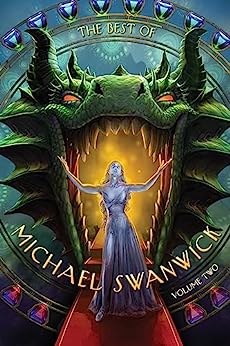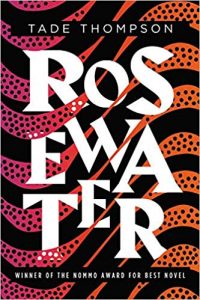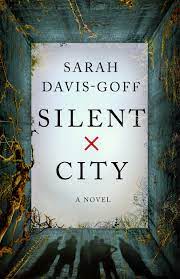Russell Letson Reviews The Best of Michael Swanwick: Volume Two by Michael Swanwick
 The Best of Michael Swanwick: Volume Two, Michael Swanwick (Subterranean 978-1-64524-112-6, $50.00, 530pp, hc) July 2023. Cover by Lee Moyer.
The Best of Michael Swanwick: Volume Two, Michael Swanwick (Subterranean 978-1-64524-112-6, $50.00, 530pp, hc) July 2023. Cover by Lee Moyer.
I keep thinking of Michael Swanwick as a Renaissance figure, an image generated by his writing, which includes generous dollops of fancy, baroque turns of imagination, and elegant prose. In 2008 a big chunk of that prose (21 stories) was gathered in The Best of Michael Swanwick, and the intervening years have generated enough additional good stuff to fill The Best of Michael Swanwick: Volume Two: fifty pages longer, a whopping 37 stories originally published between 1999 and 2022. That’s a lot of “best,” but I’m not sure that this volume even begins to exhaust that descriptor.
Much of what I find to admire here echoes what I noticed in the recent Subterranean Press “Best” collections from John Kessel and Ian R. MacLeod: a range of story types and tropes and atmospheres and a refusal to color within genre lines, while also demonstrating a complete command of those convention-sets and narrative possibilities. Swanwick explores many of the same materials as Kessel and MacLeod, but his particular way of navigating the territories of the fantastic remains, of course, his own.
A collection like this can offer a map of the writer’s career and sensibility, and Subterranean retrospective editions often feature authorial prefaces or afterwords for each story to guide such mapping. This volume, however, has only Swanwick’s four-page Introduction, “The Apple Tree, the Vacuum Tubes, and All the World Besides,” which contains striking autobiographical reflections and brief comments on fourteen of its selections. So it’s up to a reviewer to devise a map of these remarkably multifarious, N-dimensional Swanwickian landscapes – and while no single map is likely to be complete, there are landmarks and frequently trod paths and the occasional signpost.
The most persistent feature is that Renaissance vibe, where magick and science and poetry and travelers’ tales rub up against each other, worlds of contiguities and overlays and palimpsests. For example: Swanwick is fond of tricksters and con-men and -women and origin stories and stories that eat their own tails or present spaces that encompass more dimensions than four. He spins out catalogues, which I take to be a rhetorical representation of the world’s plenitude, as in the “goblin market just outside the Ivory Gate” of the Faerie city of Babel in “An Episode of Stardust”:
Vendors sold shish kabob and cotton candy, T-shirts and pashmina scarfs, gris-gris bags and enchanted swords, tame magpies and Fast Luck Uncrossing Power candles. Charango players filled the air with music.
Or, in “The Bordello in Faerie”, where an increasingly “elf-shot” young man finds himself not a patron but a provider of erotic services for a clientele that encompasses every kind of supernatural or mythic being, from a doomed elf-warrior to a slumming goddess:
fox spirits, fire women… shape-shifters, a sphinx… women whose flesh was as cold as the grave though their passions were not, and nymphs with ivy growing in their hair….
Speaking of catalogues, a list of the genre territories visited in this volume would require categories as various as Polonius’s NOUN?: science-fictional, wizardly fantastical, trickster-con-manical, epic-heroical, ironical-heroical, ironical-fantastical, farcical-heroical-fantastical…. Which is to say that Swanwick moves effortlessly across genre boundaries in the extended literary family best labeled “the fantastic” and which stretches (in Western literature) from Metamorphoses through Gawain and the Green Knight and A Midsummer Night’s Dream to Frankenstein, The Time Machine, Astounding Stories of Super-Science, Weird Tales, and Jorge Luis Borges.
Another way of seeing this volume is as several interwoven subcollections – SF both hard and “literary,” multiverse/time-travel tropes, Faerie tales and mythic mashups, along with samples from his short-story cycles. And there remain items that cross into adjacent territories or sprawl across boundaries, or duck through genre wormholes to emerge Elsewhere. Even some of the unambiguously science-fictional stories seem to wear fantasy garb.
“Tin Marsh” is the real thing, a straight-up hard-SF puzzle with a deadly planetscape setting and an exploitative corporate adaptation of Asimov’s Laws of Robotics, but applied to humans. Variations on artificial intelligence recur. “‘Hello,’ Said the Stick” is a short admonition against trusting talking weaponry that also implies an entire novel-setting around it. Machine-servant loyalty and the stretching of operational parameters drive “The Scarecrow’s Boy”, while “Steadfast Castle” is a rogue-AI story that had me thinking simultaneously of Alfred Bester’s “Fondly Fahrenheit” and Arkady Martine’s Rose/House. It is followed by a kind of companion piece (a dyadic pattern that shows up throughout the collection), “Nirvana or Bust”, in which a prosthetic exoskeleton has a mind of its own and is curious about why “so much of the human nervous system is extracranial” and why “so much of human consciousness is experienced through emotion.”
Both “Steadfast” and “Nirvana” proceed primarily via dialogue with a representative of the law – “Steadfast Castle” entirely so. “Passage of Earth” plays a similar narrative game: the first half is mostly dialogue as the protagonist conducts an autopsy on a wormlike alien – observations, speculations, tentative conclusions about the nature of the creature – but then it takes a sharp turn into another, very strange dialogue.
“Ancient Engines” is also built on talk: a barroom conversation that provides a tour through a whole sheaf of proposed SF motifs and ideas about immortality, compacting Stapledonian
vistas into a very small space. Its dyadic companion, “Starlight Express”, might be set in one of those distant futures, on the far side of any number of techno-cultural gulfs. It’s a consideration of mortality, immortality, rootlessness, belonging, and loss, set in a Roma filled with “the ruins and remnants of empire” (from our future as well as our past) and interplanetary tourists, with an ancient, broken interstellar teleportation system: “Human beings had built such things once. Now they didn’t even know how to turn it off.”
“There Was an Old Woman” is an episode in the extensive adventures of Darger and Surplus, two rascally gentlemen of the road in a more familiar kind of postcollapse SF future where, nevertheless, one can be eaten by a dragon – though that winds up more like being held prisoner on a luxury cruise liner than, say, confronting Smaug.
Which brings me to one of those crossover points. I take SF to be, in part, the result of the urge to make sense of the fantastic, but the urge to understand, to explain, to rationalize, seems too restrictive for Swanwick’s imagination, and the worlds of his stories push toward the wilder neighborhoods of the fantastic, to myth and fairy tale, and the raw material of dreams. “The Dala Horse” puts a posthuman-tech skin on what feels like a Scandinavian folk tale about trolls and tutelary spirits. There is a kind of play-fair principle operating here in which miraculous creatures and events are given a material explanation. I suspect that the feeling of the story’s world matters more than the machinery that places it in the technically SF category. Or perhaps that is the point of the exercise: to merge the rational and the miraculous, as our two eyes make one sight (to appropriate some Robert Frost).
Similarly, in “Moon Dogs”, when troubled, death-haunted Nick meets Selene the huntress and her robotic “gundogs” in the woods, the setting is officially a post-plague-catastrophe world, but it is also a re-enactment of Actaeon’s encounter with Artemis. The story also echoes images from “The She-Wolf’s Hidden Grin”, which begins with a nightmare and, through careful control of viewpoint, gradually builds up details about a society, its star-colonizing background, the nature of the perhaps-indigenous “abos”, and the status of its women, until the full waking-nightmare nature of its world is revealed. Our actual history or extrapolated future seem too narrow for Swanwick’s visions, and alternate-history or multiverse settings, which are by convention at least SF-adjacent, offer one way around that constraint. “The Skysailor’s Tale” begins with its narrator lamenting the state of his memories:
[M]ost of my life had been burnt to ashes and those ashes swept into the ash pit of history. The Atlantis of my past was sunk; all that remained were a few mountain tops sticking up out of the waters of forgetfulness like a scattered archipelago of disconnected islands.
Nevertheless, much of the first part of the story consists of precise and vivid evocations of place, in this case, old Philadelphia in an early 19th century that turns out not to be ours. The rest outlines the narrator’s voyage on the airship Empire, its search of El Dorado, and the manner of its loss and his homecoming – or, at least, his return to a home. “Pushkin the American” pursues the might-have-been signaled by its title through some extravagant evolutions before landing back in the world as it might as well have been. “Here are the facts,” writes the narrator. “Make of them what you will.”
“The Mongolian Wizard” is the beginning of a story cycle that combines alternate worlds with magic-as-technology tropes and secret-agent-intrigue in what feels like a magic-powered analogue of WWI. A later entry in the series, “The New Prometheus”, uses the setting for an homage to Frankenstein, complete with the embedded narrative of how the magicially created “homunculus” came to his determination to live a moral life in a fallen world.
The range of fantasy tropes and types is extensive. “Of Finest Scarlet Was Her Gown” is an extended variation on the deal-with-the-devil story in which hell is “a city like any other save that there was nothing good to be said about it.” “Dragon Slayer” plays games with barbarian-warrior tropes – and with time and gender roles and the fates of heroes. “An Episode of Stardust” is set in the world of The Iron Dragon’s Daughter (or some version of it), with Nat Whilk on the road and on the con, telling his outrageous story- within- a-story about the competition for a bag with “twenty ounces of industrial-grade stardust.” “Goblin Lake” is a metafictional fairytale that concludes that it’s perhaps more satisfying to live in real life, “subject to the whims of history” (even at the cost of immortality), than in storybook perfection.
“Annie Without Crow” occupies a kind of Faerie/multiverse frame populated by all manner of supernatural beings and archetypes. It is also descended from scorned-fairy-godmother stories, but with a dose of the squabbling godlets of A Midsummer Night’s Dream and a hint of how news of that might have entered our world, via Annie’s new pet poet, the mortal boy Will. Annie is the avatar of Romance, which is, as she declares, anything but “neat and tidy.”
It invades the heart like a conquering army and it takes no prisoners. Whatever stands in its way it lays to waste. Family, friends, duty, love of country, common sense – all fall before it. Decency is set aflame! Morality is tossed aside! Reason is trampled underfoot! Self-preservation? Don’t make me laugh. There has never been a tyrant more ruthless or less prone to mercy than I.
Dig deeper into fantasy and you get to its roots in myth. “Urdumheim” is a kind of mythic-origins story, told by a second-generation witness, about (among other things) the creative and organizing power of language. In “The Last Days of Old Night”, three giant, troll-like brothers command all the things of the world before the birth of light – except for the sea and a clever, determined mouse-woman.
The strangest stories defy easy classification. “Eighteen Songs by Debussy” is one whose block of notes was last to find its place in this review. It is conceptually science fiction: a world governed by inscrutable machine Intelligences, where body- and mind-swapping are routine and human life can be a commedia dell’arte carnevale. Structurally, it is a fractured, modernist narrative, its sections named for the art songs that are its inspiration. It is a world seen in glimpses and fragments, and it moves from snapshots of erotic decadence and faithlessness to a darker picture of a war among the Intelligences with “causes…complex beyond human intelligence”, nevertheless fought by human proxies and resulting in “more-than-hallucinatory gore.”
In the Introduction, Swanwick writes that “Universe Box” is “the single work here I am most pleased with.” It is a deliberately wonky piece, constructed according to a process (described in the Introduction) that I would call “aleatory.” The author admits that it has a “rambunctious, wandering plot,” but what can you expect of a story driven by a (“possibly the”) trickster, featuring as its MacGuffin “a box containing everything that anybody could possibly desire”? (Its contents are alluded to in a lovely catalogue too long to quote here.) The story ends with what I take to be an homage to the finale of James Joyce’s “The Dead”, but more generous and serene.
Which makes “Universe Box” a figure for this entire collection and for Swanwick’s art in general. His narrative technique seems as restless and transformative as his imagination, with embedded narratives, sleight-of-genre magic and emotional rollercoasters, trapdoors, and sudden cadences that surprise and satisfy – and those catalogues. His great themes, I think, are mutability and mortality, which are not exactly the same thing. As Robert Louis Stevenson observed, “The world is so full of a number of things,/ I’m sure we should all be as happy as kings.” Except, of course, that we are not, and that’s okay, too, because, as the trickster reminds us, “This is the price of being alive. We fall down at the end.” And still, the miraculous is all around us.
Russell Letson, Contributing Editor, is a not-quite-retired freelance writer living in St. Cloud MN. He has been loitering around the SF world since childhood and been writing about it since his long-ago grad school days. In between, he published a good bit of business-technology and music journalism. He is still working on a book about Hawaiian slack key guitar.
This review and more like it in the July 2023 issue of Locus.
 While you are here, please take a moment to support Locus with a one-time or recurring donation. We rely on reader donations to keep the magazine and site going, and would like to keep the site paywall free, but WE NEED YOUR FINANCIAL SUPPORT to continue quality coverage of the science fiction and fantasy field.
While you are here, please take a moment to support Locus with a one-time or recurring donation. We rely on reader donations to keep the magazine and site going, and would like to keep the site paywall free, but WE NEED YOUR FINANCIAL SUPPORT to continue quality coverage of the science fiction and fantasy field.
©Locus Magazine. Copyrighted material may not be republished without permission of LSFF.








